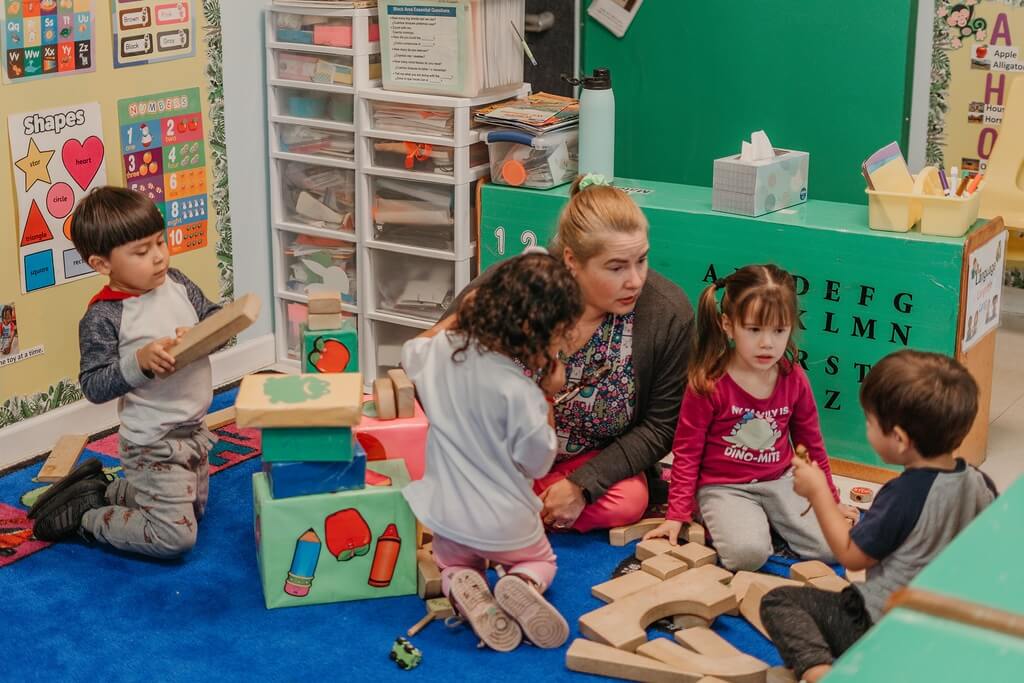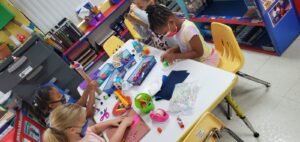Our preschool in Lake Worth is a magical time in a child’s life. There, they embark on a journey of exploration and creativity. It’s a time when they learn not just their ABCs and 123s but also crucial life skills that will shape their future.
A preschool educator must ensure an environment fostering learning, growth, and creativity. Here is where preschool classroom management comes into play. This blog post will explore crucial strategies and techniques for effective classroom management in a preschool setting.
We’ll explore how to create a positive learning environment, build meaningful teacher-student relationships, include inclusive practices, and collaborate with parents for a comprehensive Creative Learning Experience.
How to Manage a Preschool Classroom?
Classroom management in preschool is an art, blending structure and flexibility to meet the unique needs of young learners. To ensure a harmonious classroom, consider the following key elements:
Establish a Positive Classroom Environment
Preschool classroom management begins with creating an environment where children feel safe, valued, and excited to learn. Here are some strategies to make your classroom an inviting and nurturing space:
- Creating a safe and welcoming space: Ensure that your classroom is organized and free of hazards. Utilize child-friendly furniture, soft play areas, and vibrant colors to create an inviting atmosphere. Consider designating cozy corners for quiet activities and areas for active play.
- Setting clear expectations and rules: Preschoolers thrive with structure. Develop simple, age-appropriate rules and expectations for behavior in your classroom. Ensure these rules are communicated clearly to the children.
- Developing a classroom routine: Children feel secure knowing what to expect. Establish a daily routine with time for learning, play, snacks, and rest. Be consistent with this schedule.
- Modeling positive behavior: Children often learn by example. Demonstrate the behavior you expect from them, such as sharing, using kind words, and problem-solving.
- Organize classroom materials: Keep materials organized and accessible. Label bins and shelves, and teach children how to return items when they’re finished with them.
- Foster emotional intelligence: Create opportunities for children to express their emotions and talk about their feelings. Teach them the importance of recognizing and managing their emotions.
- Encourage social interaction: Plan activities that promote interaction and cooperation among children. Group projects, games, and collaborative play help build social skills.
- Teach empathy and problem-solving: Guide children in understanding the feelings of others and resolving conflicts peacefully. Encourage them to talk through their issues and find solutions.
- Use visual aids: Visual aids, like charts and posters, can help children understand rules and routines better. Incorporate images and words to make these tools more engaging.
Build Positive Teacher-Student Relationships
Creating strong connections with your preschool students is vital for effective classroom management. Here’s how you can build meaningful relationships:
- Create a warm and inclusive environment: Make children feel valued and respected. Greet them smiling, use their names, and celebrate their achievements.
- Effective communication with preschoolers: Use simple and clear language. Listen when children talk and ask open-ended questions to encourage conversation.
- Build trust and rapport: Consistency in your actions and words is key to building trust. Be reliable, supportive, and responsive to children’s needs and concerns.
- Praise and encouragement: Recognize and praise children’s efforts and achievements. Positive reinforcement boosts their confidence and motivation to learn.
- Consistency: Children thrive when they know what to expect. Consistent routines, rules, and consequences help them feel secure and understand boundaries.
- Individualized support: Each child is unique, with their strengths and challenges. Tailor your teaching and support students to meet individual needs, ensuring no child is left behind.
- Social-emotional learning: Teach children to understand and manage their emotions. Encourage them to express their feelings and provide guidance on resolving conflicts peacefully.
- Peer interactions: Foster a sense of community by promoting cooperative play and group activities. Encourage children to work together, share, and collaborate.
Include Inclusive Practices and Special Needs
Every child is unique, and effective classroom management involves accommodating diverse needs. Here are more strategies to ensure inclusivity and support for all children:
- Create an inclusive classroom: Adapt your teaching methods to accommodate all children, including those with special needs. Provide a diverse and flexible curriculum that allows each child to learn at their own pace.
- Accommodate the needs of all learners: If you have children with special needs, provide extra support, individualized lessons, and adaptations to ensure their success.
- Challenge advanced learners: Remember the children who excel. Offer them advanced activities and projects to keep them engaged and excited about learning.
- Conflict resolution: Teach children effective conflict resolution skills, helping them navigate disagreements peacefully and independently.
- Time management: Introduce time management skills by creating a daily schedule and teaching children to manage their time effectively during activities and transitions.
- Self-control: Encourage self-regulation and self-control through activities that promote patience, impulse control, and managing emotions.
- Cooperative play: Promote cooperative play and teamwork. Organize group activities encouraging children to collaborate and communicate effectively with their peers.
- Problem-solving skills: Develop problem-solving skills by presenting children with challenges and guiding them to find creative solutions independently or as a group.
Implement Positive Behavior Support (PBS)
PBS offers a structured approach to behavior management in preschool settings. It encompasses strategies to prevent challenging behaviors and promote positive ones through a Pyramid Model that offers a structured framework based on evidence-based practices to promote social-emotional development in children, address the needs of those at risk, and provide tailored support for children with persistent social, emotional, or behavioral challenges.
The Pyramid Model consists of three tiers:
- Tier 1: This foundational level emphasizes nurturing caregiving relationships and creating high-quality environments. It focuses on developing relationships, nurturing responsive support, engaging children, and promoting social-emotional skills.
- Tier 2: The second tier serves as a prevention level, focusing on explicit social skills instruction. It covers self-regulation, emotional expression and understanding, social relationships, and problem-solving.
- Tier 3: The top tier offers individualized, intensive interventions for children with the most persistent challenging behaviors. Even with Tiers 1 and 2 in place, some young children may require an individualized behavior support plan.
Leveraging the Pyramid Model, which follows a tiered approach, can significantly enhance the successful implementation of PBS. Here are key strategies:
- Staff training: Begin with comprehensive training for all staff members, introducing them to PBS principles and the Pyramid Model’s tiered approach.
- Leadership team: Form a dedicated team comprising program administrators, teaching staff, coaches, behavior specialists, and family members to oversee PBS implementation.
- Clear behavior expectations: Clearly define and communicate consistent behavior expectations for all children, using visual aids and simple language.
- Family engagement: Engage families by sharing behavior expectations and involving them in goal-setting and monitoring progress.
- Positive reinforcement: Implement a positive reinforcement system to motivate children to continue positive behavior. Consistent, specific praise and rewards are essential.
- Data collection and analysis: Collect data on behavior incidents, interventions, and outcomes. Regularly analyze this data to evaluate the effectiveness of your strategies and make necessary adjustments.
- Consistency: Maintain consistency in the application of PBS strategies throughout the classroom.
- Ongoing training and coaching: Provide staff with continuous training and coaching to effectively enhance their ability to implement Pyramid Model practices.
- Support for challenging behavior: Develop a system for supporting children with persistent challenging behavior, including a behavior support plan.
- Continuous review: Periodically review and adjust PBS strategies based on observed needs and outcomes.
Parent-Teacher Collaboration
Collaborating with parents is essential for a holistic preschool experience. Here are some ways to enhance parent-teacher collaboration and create a supportive educational partnership:
- Communicate classroom expectations and rules: Keep parents informed about classroom rules and expectations. Share the strategies you’re using for classroom management.
- Create a consistent learning environment: Encourage parents to reinforce classroom rules and routines at home. Consistency between home and school helps children better understand and follow expectations.
- Encourage parents to support their child’s behavior at home: Provide them with resources and tips for reinforcing positive behavior and social skills.
- Involve parents in classroom activities: Hosting events, workshops, and family engagement activities can help parents feel more connected to their child’s education.
- Individualized support plans: Work with parents to develop individualized plans for children with special needs or challenges. Regularly review progress and make necessary adjustments.
- Homework and learning extension: Provide parents with age-appropriate learning activities and homework assignments that align with the classroom curriculum, allowing children to continue their learning journey at home.
- Regular progress updates: Maintain open lines of communication with parents through regular progress reports, sharing both academic and social development milestones.
- Parent-teacher conferences: Conduct periodic parent-teacher conferences to discuss each child’s progress, goals, and areas for improvement. Collaborate on strategies for supporting learning and development.
- Parent workshops and resources: Offer workshops and resources on parenting and early childhood development. Provide information on classroom management strategies and how parents can reinforce them at home.
In the intricate world of preschool education, classroom management is the cornerstone that shapes the creative learning experience of our little ones.
From establishing a positive classroom environment, building strong teacher-student relationships, accommodating diverse needs, and collaborating with parents, every facet of preschool classroom management plays a vital role in shaping our future leaders. It’s not just about creating rules or routines; it’s about creating an environment where curiosity, empathy, and resilience flourish.
As educators, we hold the key to unlocking the potential of each child and guiding them toward a bright and promising future. By implementing these strategies and embracing the unique needs of every child, we can ensure that our preschool classrooms become a place where children are taught and empowered to become the best versions of themselves.




